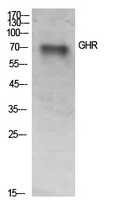产品名称
GHR Rabbit Polyclonal Antibody
别名
GHR; Growth hormone receptor; GH receptor; Somatotropin receptor
蛋白名称
Growth hormone receptor
存储缓冲液
Liquid in PBS containing 50% glycerol, 0.5% BSA and 0.02% New type preservative N.
Human Gene Link
http://www.ncbi.nlm.nih.gov/sites/entrez?db=gene&term=2690
Human Swissprot No.
P10912
Human Swissprot Link
http://www.uniprot.org/uniprotkb/P10912/entry
Mouse Gene Link
http://www.ncbi.nlm.nih.gov/sites/entrez?db=gene&term=14600
Mouse Swissprot No.
P16882
Mouse Swissprot Link
http://www.uniprot.org/uniprot/P16882
Rat Gene Link
http://www.ncbi.nlm.nih.gov/sites/entrez?db=gene&term=25235
Rat Swissprot Link
http://www.uniprot.org/uniprot/P16310
免疫原
The antiserum was produced against synthesized peptide derived from the N-terminal region of human GHR. AA range:21-70
特异性
GHR Polyclonal Antibody detects endogenous levels of GHR protein.
稀释度
WB 1:500 - 1:2000. ELISA: 1:10000. Not yet tested in other applications.
宿主
Polyclonal, Rabbit,IgG
背景介绍
This gene encodes a member of the type I cytokine receptor family, which is a transmembrane receptor for growth hormone. Binding of growth hormone to the receptor leads to receptor dimerization and the activation of an intra- and intercellular signal transduction pathway leading to growth. Mutations in this gene have been associated with Laron syndrome, also known as the growth hormone insensitivity syndrome (GHIS), a disorder characterized by short stature. In humans and rabbits, but not rodents, growth hormone binding protein (GHBP) is generated by proteolytic cleavage of the extracellular ligand-binding domain from the mature growth hormone receptor protein. Multiple alternatively spliced transcript variants have been found for this gene.[provided by RefSeq, Jun 2011],
组织表达
Expressed in various tissues with high expression in liver and skeletal muscle. Isoform 4 is predominantly expressed in kidney, bladder, adrenal gland and brain stem. Isoform 1 expression in placenta is predominant in chorion and decidua. Isoform 4 is highly expressed in placental villi. Isoform 2 is expressed in lung, stomach and muscle. Low levels in liver.
细胞定位
Cell membrane; Single-pass type I membrane protein. On growth hormone binding, GHR is ubiquitinated, internalized, down-regulated and transported into a degradative or non-degradative pathway. .; [Isoform 2]: Cell membrane; Single-pass type I membrane protein. Remains fixed to the cell membrane and is not internalized.; [Growth hormone-binding protein]: Secreted. Complexed to a substantial fraction of circulating GH. .
信号通路
Cytokine-cytokine receptor interaction;Neuroactive ligand-receptor interaction;Jak_STAT;
功能
disease:Defects in GHR are a cause of Laron dwarfism [MIM:262500]; also known as pituitary dwarfism II; Laron-type pituitary dwarfism I (LTD1) or Laron syndrome (LS). It is the most severe form of growth hormone insensitivity (GHI) characterized by growth impairment, dysmorphic facial features and truncal obesity. Levels of GHBP are low or undetectable in patients with Laron syndrome.,disease:Defects in GHR may be a cause of short stature [MIM:604271]. Short stature is defined by a subnormal rate of growth.,domain:The box 1 motif is required for JAK interaction and/or activation.,domain:The extracellular domain is the ligand-binding domain representing the growth hormone-binding protein (GHBP).,domain:The ubiquitination-dependent endocytosis motif (UbE) is required for recruitment of the ubiquitin conjugation system on to the receptor and for its internalization.,domain:The WSXWS motif appears to be necessary for proper protein folding and thereby efficient intracellular transport and cell-surface receptor binding.,function:Isoform 2 up-regulates the production of GHBP and acts as a negative inhibitor of GH signaling.,function:Receptor for pituitary gland growth hormone involved in regulating postnatal body growth. On ligand binding, couples to the JAK2/STAT5 pathway.,function:The soluble form (GHBP) acts as a reservoir of growth hormone in plasma and may be a modulator/inhibitor of GH signaling.,polymorphism:Genetic variation in GHR may act as phenotype modifier in familial hypercholesterolemia [MIM:143890] patients carrying a mutation in the LDLR gene.,PTM:On GH binding, phosphorylated on tyrosine residues in the cytoplasmic domain by JAK2.,PTM:On ligand binding, ubiquitinated on lysine residues in the cytoplasmic domain. This ubiquitination is not sufficient for GHR internalization.,PTM:The soluble form (GHBP) is produced by phorbol ester-promoted proteolytic cleavage at the cell surface (shedding) by ADAM17/TACE. Shedding is inhibited by growth hormone (GH) binding to the receptor probably due to a conformational change in GHR rendering the receptor inaccessible to ADAM17.,similarity:Belongs to the type I cytokine receptor family. Type 1 subfamily.,similarity:Contains 1 fibronectin type-III domain.,subcellular location:On growth hormone binding, GHR is ubiquitinated, internalized, down-regulated and transported into a degradative or non-degradative pathway.,subcellular location:Remains fixed to the cell membrane and is not internalized.,subunit:On growth hormone (GH) binding, forms homodimers and binds JAK2 via a box 1-containing domain (By similarity). Binding to SOCS3 inhibits JAK2 activation, binding to CIS and SOCS2 inhibits STAT5 activation (By similarity). Interacts with ADAM17.,tissue specificity:Expressed in various tissues with high expression in liver and skeletal muscle. Isoform 4 is predominantly expressed in kidney, bladder, adrenal gland and brain stem. In the placenta, isoform 1 predominantly expressed in chorion and decidua, isoform 4 highly expressed in villi. Isoform 2 is expressed in lung, stomach and muscle. Low levels in liver.,
纯化
The antibody was affinity-purified from rabbit antiserum by affinity-chromatography using epitope-specific immunogen.

